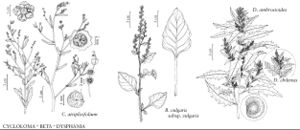Cycloloma
Chenop. Monogr. Enum., 17. 1840.
| Taxon | Illustrator ⠉ | |
|---|---|---|
 | Cycloloma atriplicifolium Beta vulgaris subsp. vulgaris Dysphania chilensis | Bee F. Gunn Yevonn Wilson-Ramsey Yevonn Wilson-Ramsey |
Herbs, annual, polygamomonoecious, villose or tomentulose, becoming glabrous at maturity. Stems erect, much branched, especially in inflorescence, not jointed, not armed, not fleshy. Leaves alternate, petiolate or almost sessile; blade oblong-ovate, oblong, or lanceolate, base cuneate, margins sinuate-dentate, apex acute or mucronate. Inflorescences diffusely branched, paniculate, interrupted, linear spikes; flowers solitary or few in axils of short bracts. Flowers bisexual or pistillate; perianth segments 5, connate to above middle; stamens 5; stigmas 3. Fruiting structure: connate perianth segments enclosing utricle, at maturity forming horizontal, membranous, circular wing; pericarp membranous, free. Seeds horizontal, ovate-lenticular or globose-lenticular; seed-coat black, smooth or indistinctly sculptured; embryo annular, perisperm copious. x = 9.
Distribution
North America, occasionally adventive in South America and Europe
Discussion
Species 1.
Traditionally, Cycloloma has been included in Chenopodieae (Chenopodiodeae). Recently it was placed in Camphorosmioideae (A. J. Scott 1978), mostly due to the presence of the broad wing formed by the encircling perianth segments. However, the development of the wing in Cycloloma seems to be very different from the mode of development of a similar wing (or other appendages) in Kochia, Bassia, and other genera of Camphorosmioideae. In my opinion, Cycloloma is more closely related to Chenopodium in the broad sense; the problem of its proper placement requires additional study.
Selected References
None.